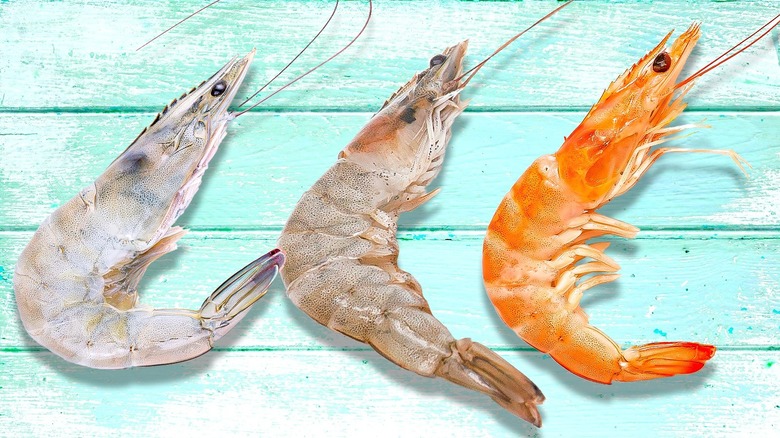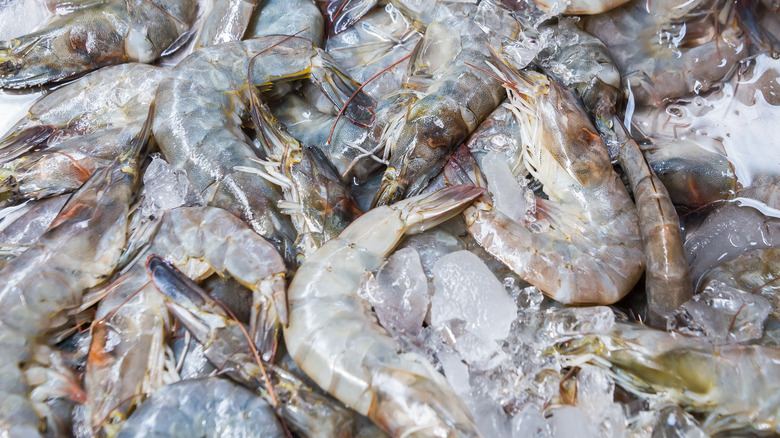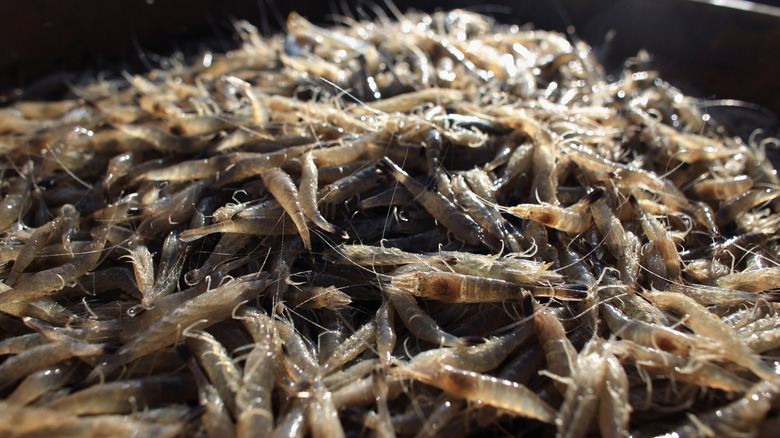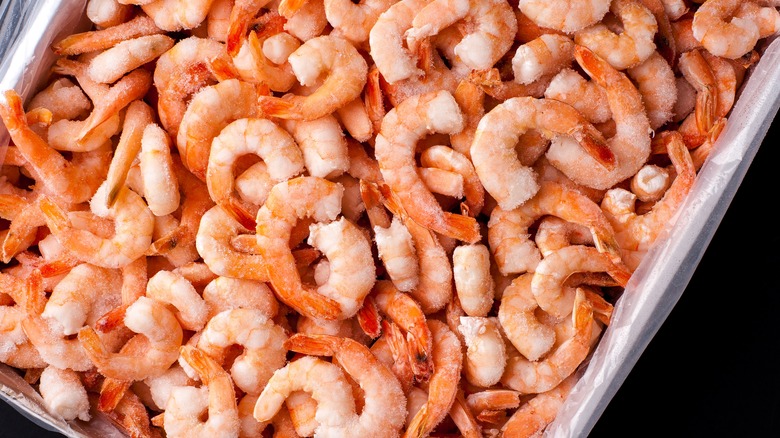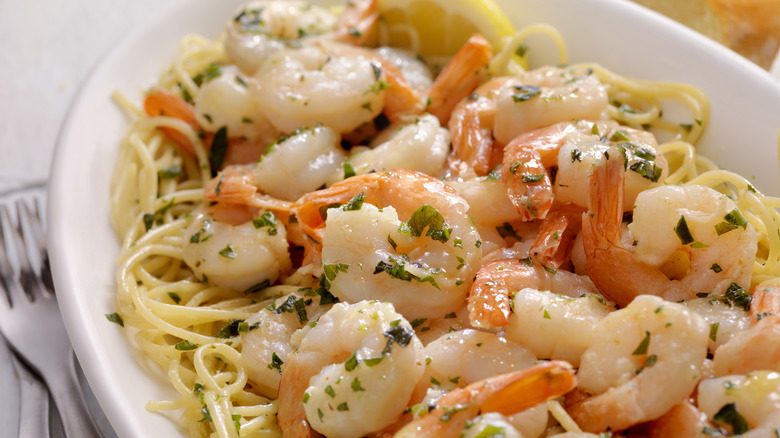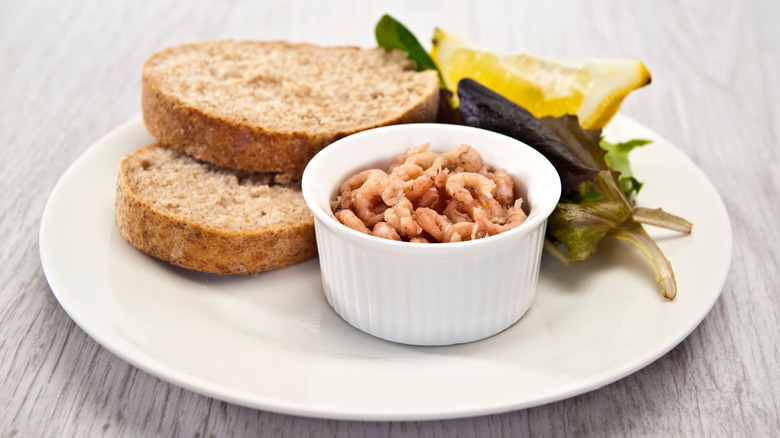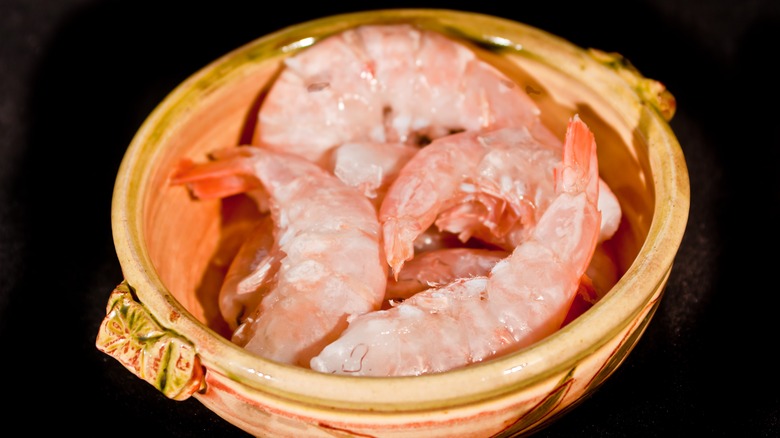Does The Color Of Your Shrimp Matter? Here's The Difference Between White, Brown, And Pink
It might not be your cup of tea but every home cook should experience the sensory stimulation that comes from shopping at the wet market. Aside from the buzz of activity from sellers, shoppers, and porters, you will also catch the briny scent of freshly caught seafood and spot iridescent colors you rarely see on land on fish scales and the exoskeletons of shellfish. Even the humble shrimp, the so-called cockroaches of the sea, come in a range of shades, from vibrant crimson to the pink and brown striations seen on Asian tiger shrimp.
White, brown, and pink shrimp are the types you'll find in most markets. These species of the penaeid shrimp are cultured across the globe, from South and Southeast Asia to South America. Knowing the differences between these three types of shellfish is important since their color is an indication of their preferred habitats. With bodies of water having different salinity levels, where a shrimp was caught or farmed is an indication of its flavor. The vegetation available in its natural environment and which it feeds on also contributes to how a shrimp tastes.
Familiarizing yourself with each shrimp type's characteristics could prove helpful in the kitchen. Planning meals where this seafood is the main attraction becomes easier since you'll know which cooking methods will work best in bringing out their flavor. The next time you're in the market for some shrimp, examine them not just for their size and freshness but for their colors, too.
What are white shrimp?
Also known as Pacific white shrimp or whiteleg shrimp, white shrimp is one of the most widely available shrimp varieties worldwide. They're fast and easy to cultivate, with mature white shrimp available for harvest after only 120 days and reaching up to eight inches in length. They can also be caught in the wild and then kept frozen aboard the fishing vessel until it reaches the shore, but the farmed variant has the advantage of getting delivered straight to the market. They've been genetically bred to be disease-resistant as well.
Despite having "white" in their name, the raw flesh of this shrimp type can range in color from translucent white to reddish-brown. Once it gets cooked, however, it turns white with a pink tinge. The color a white shrimp develops depends on its food and the water turbidity in its habitat, which are usually estuaries and coastal areas. Their shells are also easier to remove compared to those of other shrimp types.
What are brown shrimp?
Brown shrimp or "brownies" come in two stocks: the Gulf of Mexico and the South Atlantic stocks. They typically live in water that's no more than 180 feet deep inshore where they feed on the organic matter found in mud and peat. However, once they need to spawn, they migrate to the saltier depths of the sea, staying at the soft combination of sand and mud at its bottom. Depending on the salinity and water temperature of their habitat, brown shrimp can grow up to seven inches in length. Aside from their namesake color, they can also appear gray in hue with some green and red pigmentation. You might also see a purple band in their tails.
The brown shrimp you find at the fishmonger have very likely been boiled already because this variety is ideally cooked while the shrimp are still alive. Otherwise, their flesh would end up mushy and off-putting.
What are pink shrimp?
Pink shrimp is also referred to as spotted shrimp. Its delicate color is due to astaxanthin, a carotenoid that is found in the microalgae and phytoplankton they feed on. As pink shrimp get cooked, the heat releases these carotenoids from the protein chains that cover them, thus intensifying the color of the shrimp's flesh. Pink shrimp are also relatively small: Their average length rarely goes over five inches, although they can grow to over eight inches, depending on their habitat's water temperature and salinity.
Around 75% of the pink shrimp that are harvested and available in the U.S. come from the Florida west coast (per NOAA Fisheries). In their juvenile stage, these shrimp live in nursery areas with marsh grasses that provide them with food and shelter. They also prefer areas with sand, sand-shell, or coral-mud bottoms where they can burrow to protect themselves from the cold. As they mature, however, they move toward the deeper, saltier parts of the sea.
White shrimp absorbs the flavors of other ingredients well
White shrimp are known for their delicately sweet taste and succulent texture, which is more tender compared to other types. The best way to let their flavor come through is by sauteing, boiling, grilling, frying, or steaming them. They are also versatile ingredients for stir-fries, soups, and pasta because of how well they can absorb other flavors while adding their distinct seafood flavor to a dish at the same time.
To enhance their firm texture, you can wash white shrimp with sugar and baking soda. This cooking prep can give your next batch of shrimp siu mai that Chinese restaurant-worthy crunch. Marinate them, too, in garlic, paprika, and black pepper to create the base for a garlic shrimp dish. You can then skewer and grill them like kebabs or simmer them in coconut milk. Regardless of how you prepare them, be careful not to overcook white shrimp since this makes their flesh turn rubbery.
Brown shrimp have a robust umami taste due to their diet
The firm flesh of brown shrimp also has a sweetness to it but because of shrimp's diet, the flavor also comes with an umami brininess that's more distinct in comparison to those of white and pink shrimp. Sometimes, it is even described as having an iodine-like tinge to it. A study by the Texas AgriLife Extension Service credits that taste to the marine compound bromophenol that is found in marine prey species, which shrimp feed on. Bromophenol is responsible for that flavor that gets described as "ocean-like" and "sea-fresh." Compared to wild-caught seafood, farmed ones have a milder ocean-like taste since adding bromophenol compounds to commercial feed doesn't quite replicate the flavor that a shrimp would develop from its natural diet.
When cooked, brown shrimp's firm, gray-brown flesh turns into sunset-orange. Combined with its robust flavor, this shrimp type is perfect for rich dishes like gumbos, curries, seafood soups, and stews. They can also be used in the traditional English dish potted shrimp in place of prawn. Their heads and shells can also be boiled to make sauces and stocks so they are infused with the deliciously briny flavor of this shellfish.
Pink shrimp are prized for their sweetness
Aside from their rosy color that makes this type the first one you imagine when you think of shrimp, pink shrimp are popular because of their sweet and tender meat, with their sweetness more pronounced than that of white shrimp. They also make colorful additions to a plate. However, smaller-sized ones have limited culinary applications because pink shrimp take a short time to cook — around two to three minutes only per side. You can tell they are done once the bodies lose translucency and the tails curl up.
You can saute, fry, boil, and steam pink shrimp that are of considerable size and then use the smaller ones in salads and as garnish for pasta and noodle dishes, like the Filipino dish pancit palabok. Their sweetness is also a great counterpoint to the heat in a freshly cooked plate of spicy shrimp scampi. Try them, too, when making a classic shrimp cocktail.
